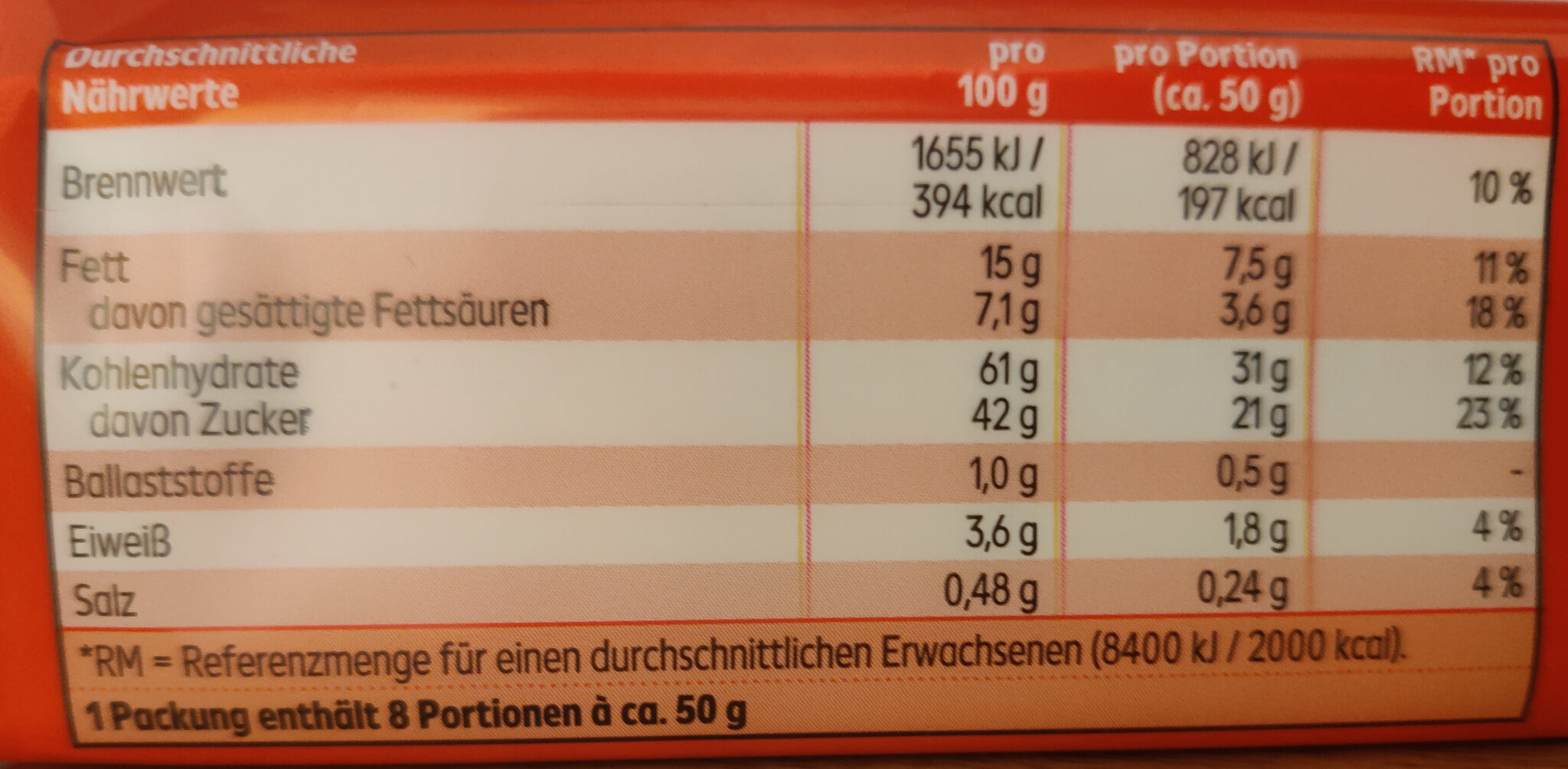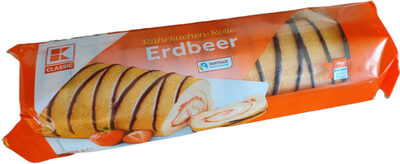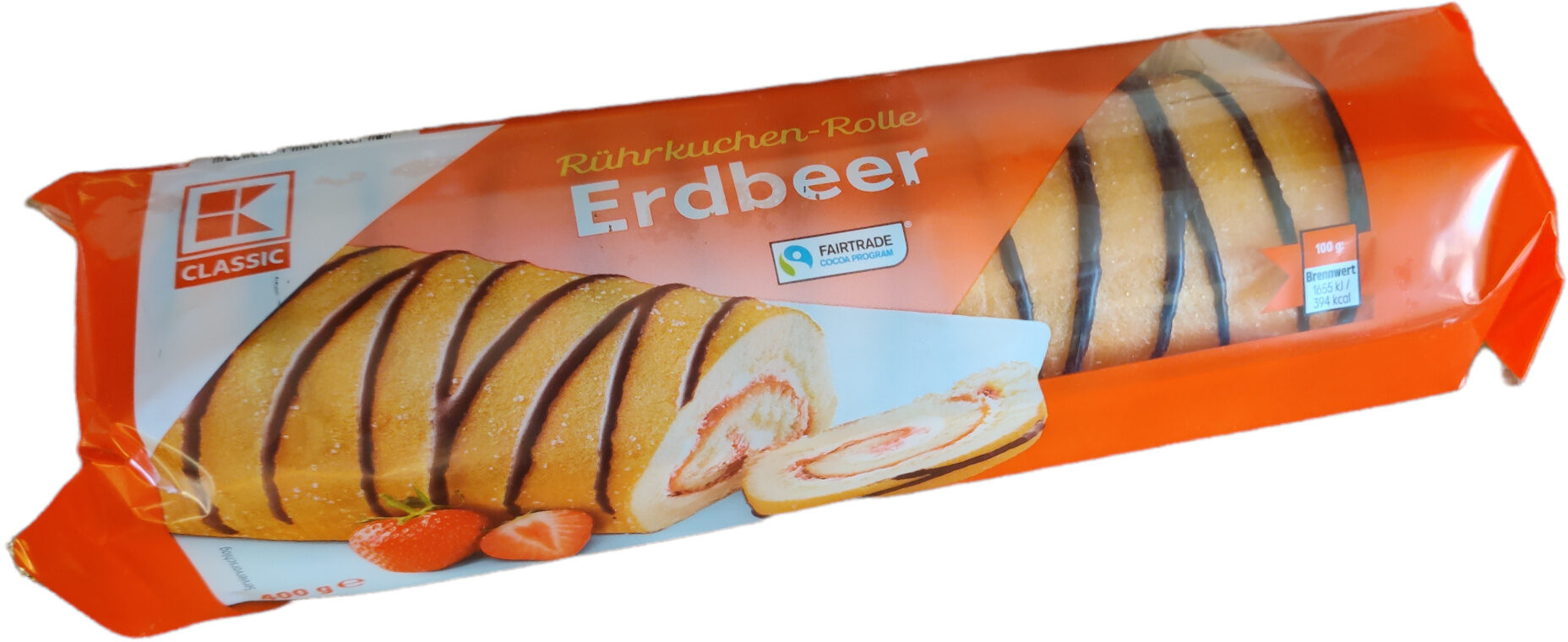Help us make food transparency the norm!
As a non-profit organization, we depend on your donations to continue informing consumers around the world about what they eat.
The food revolution starts with you!
K-Classic Rührkuchen-Rolle Erdbeer - 400g
K-Classic Rührkuchen-Rolle Erdbeer - 400g
This product page is not complete. You can help to complete it by editing it and adding more data from the photos we have, or by taking more photos using the app for Android or iPhone/iPad. Thank you!
×
Barcode: 4337185639050 (EAN / EAN-13)
Common name: Rührkuchen-Rolle mit 30% Creme- und 20% Erdbeerfruchtfüllung, dekoriert mit 1% dunklen kakaohaltigen Fettglasurwellen
Quantity: 400g
Packaging: Kunststoff, Pappe
Brands: K-Classic
Categories: Snacks, Sweet snacks, Biscuits and cakes, Cakes, Pound Cake, Imbiss, Kekse und Kuchen, Kuchen, Rührkuchen, Süßer Snack, Süßwaren
Labels, certifications, awards:
Fair trade, Fairtrade International, Fairtrade cocoa, Fairer Handel
Manufacturing or processing places: Dan Cake Deutschland GmbH, Salzkotten, Deutschland
Stores: Kaufland
Countries where sold: Deutschland
Matching with your preferences
Health
Ingredients
-
33 ingredients
: Zucker, Glukose-Fruktose-Sirup, Weizenmehl, Palmfett, Eier, Erdbeeren (6%), Weizenstärke, Dextrose, Feuchthaltemittel (Glycerin), ganz gehärtetes Palmfett, Rapsöl, Magermilchpulver, Emulgatoren (Mono - und Diglyceride von Speisefettsäuren, Lecithine), Säureregulatoren (Natriumacetate, Citronensäure, Natriumcitrate), Milcheiweiß, Backtriebmittel (Diphosphate, Natriumcarbonate), Speisesalz, fettarmes Kakaopulver, Konservierungsstoff (Kaliumsorbat), Geliermittel (Pektine), natürliches Aroma, färbendes Lebensmittel (Holunderbeersaftkonzentrat).Allergens: Eggs, Gluten, MilkTraces: En-nuts-en-soybeans
Food processing
-
Ultra processed foods
Elements that indicate the product is in the 4 - Ultra processed food and drink products group:
- Additive: E322 - Lecithins
- Additive: E422 - Glycerol
- Additive: E440 - Pectins
- Additive: E450 - Diphosphates
- Additive: E471 - Mono- and diglycerides of fatty acids
- Ingredient: Colour
- Ingredient: Dextrose
- Ingredient: Emulsifier
- Ingredient: Flavouring
- Ingredient: Gelling agent
- Ingredient: Glucose
- Ingredient: Humectant
- Ingredient: Milk proteins
Food products are classified into 4 groups according to their degree of processing:
- Unprocessed or minimally processed foods
- Processed culinary ingredients
- Processed foods
- Ultra processed foods
The determination of the group is based on the category of the product and on the ingredients it contains.
Additives
-
E202 - Potassium sorbate
Potassium sorbate (E202) is a synthetic food preservative commonly used to extend the shelf life of various food products.
It works by inhibiting the growth of molds, yeast, and some bacteria, preventing spoilage. When added to foods, it helps maintain their freshness and quality.
Some studies have shown that when combined with nitrites, potassium sorbate have genotoxic activity in vitro. However, potassium sorbate is generally recognized as safe (GRAS) by regulatory authorities.
-
E262 - Sodium acetates
Sodium acetate: Sodium acetate, CH3COONa, also abbreviated NaOAc, is the sodium salt of acetic acid. This colorless deliquescent salt has a wide range of uses.Source: Wikipedia
-
E322 - Lecithins
Lecithins are natural compounds commonly used in the food industry as emulsifiers and stabilizers.
Extracted from sources like soybeans and eggs, lecithins consist of phospholipids that enhance the mixing of oil and water, ensuring smooth textures in various products like chocolates, dressings, and baked goods.
They do not present any known health risks.
-
E330 - Citric acid
Citric acid is a natural organic acid found in citrus fruits such as lemons, oranges, and limes.
It is widely used in the food industry as a flavor enhancer, acidulant, and preservative due to its tart and refreshing taste.
Citric acid is safe for consumption when used in moderation and is considered a generally recognized as safe (GRAS) food additive by regulatory agencies worldwide.
-
E331 - Sodium citrates
Sodium citrate: Sodium citrate may refer to any of the sodium salts of citrate -though most commonly the third-: Monosodium citrate Disodium citrate Trisodium citrateThe three forms of the salt are collectively known by the E number E331. Sodium citrates are used as acidity regulators in food and drinks, and also as emulsifiers for oils. They enable cheeses to melt without becoming greasy.Source: Wikipedia
-
E422 - Glycerol
Glycerol: Glycerol -; also called glycerine or glycerin; see spelling differences- is a simple polyol compound. It is a colorless, odorless, viscous liquid that is sweet-tasting and non-toxic. The glycerol backbone is found in all lipids known as triglycerides. It is widely used in the food industry as a sweetener and humectant and in pharmaceutical formulations. Glycerol has three hydroxyl groups that are responsible for its solubility in water and its hygroscopic nature.Source: Wikipedia
-
E440 - Pectins
Pectins (E440) are natural carbohydrates, predominantly found in fruits, that act as gelling agents in the food industry, creating the desirable jelly-like texture in jams, jellies, and marmalades.
Pectins stabilize and thicken various food products, such as desserts, confectioneries, and beverages, ensuring a uniform consistency and quality.
Recognized as safe by various health authorities, pectins have been widely used without notable adverse effects when consumed in typical dietary amounts.
-
E450 - Diphosphates
Diphosphates (E450) are food additives often utilized to modify the texture of products, acting as leavening agents in baking and preventing the coagulation of canned food.
These salts can stabilize whipped cream and are also found in powdered products to maintain their flow properties. They are commonly present in baked goods, processed meats, and soft drinks.
Derived from phosphoric acid, they're part of our daily phosphate intake, which often surpasses recommended levels due to the prevalence of phosphates in processed foods and drinks.
Excessive phosphate consumption is linked to health issues, such as impaired kidney function and weakened bone health. Though diphosphates are generally regarded as safe when consumed within established acceptable daily intakes, it's imperative to monitor overall phosphate consumption to maintain optimal health.
-
E471 - Mono- and diglycerides of fatty acids
Mono- and diglycerides of fatty acids (E471), are food additives commonly used as emulsifiers in various processed foods.
These compounds consist of glycerol molecules linked to one or two fatty acid chains, which help stabilize and blend water and oil-based ingredients. E471 enhances the texture and shelf life of products like margarine, baked goods, and ice cream, ensuring a smooth and consistent texture.
It is generally considered safe for consumption within established regulatory limits.
-
E500 - Sodium carbonates
Sodium carbonates (E500) are compounds commonly used in food preparation as leavening agents, helping baked goods rise by releasing carbon dioxide when they interact with acids.
Often found in baking soda, they regulate the pH of food, preventing it from becoming too acidic or too alkaline. In the culinary world, sodium carbonates can also enhance the texture and structure of foods, such as noodles, by modifying the gluten network.
Generally recognized as safe, sodium carbonates are non-toxic when consumed in typical amounts found in food.
Ingredients analysis
-
Palm oil
Ingredients that contain palm oil: Palm fat, Palm fat
-
Non-vegan
Non-vegan ingredients: Egg, Skimmed milk powder, Milk proteins
-
Maybe vegetarian
Ingredients that may not be vegetarian: E422, E471, E322, Natural flavouring
-
Details of the analysis of the ingredients
: Zucker, Glukose-Fruktose-Sirup, Weizenmehl, Palmfett, Eier, Erdbeeren 6%, Weizenstärke, Dextrose, Feuchthaltemittel (Glycerin), Palmfett, Rapsöl, Magermilchpulver, Emulgatoren (mono- und Diglyceride von Speisefettsäuren, Lecithine), Säureregulatoren (Natriumacetate, Citronensäure, Natriumcitrate), Milcheiweiß, Backtriebmittel (Diphosphate, Natriumcarbonate), Speisesalz, fettarmes Kakaopulver, Konservierungsstoff (Kaliumsorbat), Geliermittel (Pektine), natürliches Aroma, färbendes Lebensmittel (Holunderbeer)- Zucker -> en:sugar - vegan: yes - vegetarian: yes - ciqual_proxy_food_code: 31016 - percent_min: 6 - percent_max: 70
- Glukose-Fruktose-Sirup -> en:glucose-fructose-syrup - vegan: yes - vegetarian: yes - ciqual_food_code: 31077 - percent_min: 6 - percent_max: 38
- Weizenmehl -> en:wheat-flour - vegan: yes - vegetarian: yes - ciqual_proxy_food_code: 9410 - percent_min: 6 - percent_max: 27.3333333333333
- Palmfett -> en:palm-fat - vegan: yes - vegetarian: yes - from_palm_oil: yes - ciqual_proxy_food_code: 16129 - percent_min: 6 - percent_max: 22
- Eier -> en:egg - vegan: no - vegetarian: yes - ciqual_food_code: 22000 - percent_min: 6 - percent_max: 18.8
- Erdbeeren -> en:strawberry - vegan: yes - vegetarian: yes - ciqual_food_code: 13014 - percent_min: 6 - percent: 6 - percent_max: 6
- Weizenstärke -> en:wheat-starch - vegan: yes - vegetarian: yes - ciqual_proxy_food_code: 9510 - percent_min: 0 - percent_max: 6
- Dextrose -> en:dextrose - vegan: yes - vegetarian: yes - ciqual_proxy_food_code: 31016 - percent_min: 0 - percent_max: 6
- Feuchthaltemittel -> en:humectant - percent_min: 0 - percent_max: 6
- Glycerin -> en:e422 - vegan: maybe - vegetarian: maybe - percent_min: 0 - percent_max: 6
- Palmfett -> en:palm-fat - vegan: yes - vegetarian: yes - from_palm_oil: yes - ciqual_proxy_food_code: 16129 - percent_min: 0 - percent_max: 6
- Rapsöl -> en:rapeseed-oil - vegan: yes - vegetarian: yes - from_palm_oil: no - percent_min: 0 - percent_max: 6
- Magermilchpulver -> en:skimmed-milk-powder - vegan: no - vegetarian: yes - ciqual_food_code: 19054 - percent_min: 0 - percent_max: 6
- Emulgatoren -> en:emulsifier - percent_min: 0 - percent_max: 6
- mono- und Diglyceride von Speisefettsäuren -> en:e471 - vegan: maybe - vegetarian: maybe - from_palm_oil: maybe - percent_min: 0 - percent_max: 6
- Lecithine -> en:e322 - vegan: maybe - vegetarian: maybe - percent_min: 0 - percent_max: 3
- Säureregulatoren -> en:acidity-regulator - percent_min: 0 - percent_max: 5.83333333333333
- Natriumacetate -> en:e262 - vegan: yes - vegetarian: yes - percent_min: 0 - percent_max: 5.83333333333333
- Citronensäure -> en:e330 - vegan: yes - vegetarian: yes - percent_min: 0 - percent_max: 3
- Natriumcitrate -> en:e331 - vegan: yes - vegetarian: yes - percent_min: 0 - percent_max: 2
- Milcheiweiß -> en:milk-proteins - vegan: no - vegetarian: yes - percent_min: 0 - percent_max: 5.38461538461539
- Backtriebmittel -> en:raising-agent - percent_min: 0 - percent_max: 5
- Diphosphate -> en:e450 - vegan: yes - vegetarian: yes - percent_min: 0 - percent_max: 5
- Natriumcarbonate -> en:e500 - vegan: yes - vegetarian: yes - percent_min: 0 - percent_max: 2.5
- Speisesalz -> en:salt - vegan: yes - vegetarian: yes - ciqual_food_code: 11058 - percent_min: 0 - percent_max: 0.48
- fettarmes Kakaopulver -> en:fat-reduced-cocoa-powder - vegan: yes - vegetarian: yes - ciqual_food_code: 18100 - percent_min: 0 - percent_max: 0.48
- Konservierungsstoff -> en:preservative - percent_min: 0 - percent_max: 0.48
- Kaliumsorbat -> en:e202 - vegan: yes - vegetarian: yes - percent_min: 0 - percent_max: 0.48
- Geliermittel -> en:gelling-agent - percent_min: 0 - percent_max: 0.48
- Pektine -> en:e440a - vegan: yes - vegetarian: yes - percent_min: 0 - percent_max: 0.48
- natürliches Aroma -> en:natural-flavouring - vegan: maybe - vegetarian: maybe - percent_min: 0 - percent_max: 0.48
- färbendes Lebensmittel -> fr:denree-alimentaire-colorante - percent_min: 0 - percent_max: 0.48
- Holunderbeer -> en:elderberry - vegan: yes - vegetarian: yes - ciqual_food_code: 13126 - percent_min: 0 - percent_max: 0.48
Nutrition
-
Bad nutritional quality
⚠ ️Warning: the amount of fruits, vegetables and nuts is not specified on the label, it was estimated from the list of ingredients: 6This product is not considered a beverage for the calculation of the Nutri-Score.
Positive points: 1
- Proteins: 2 / 5 (value: 3.6, rounded value: 3.6)
- Fiber: 1 / 5 (value: 1, rounded value: 1)
- Fruits, vegetables, nuts, and colza/walnut/olive oils: 0 / 5 (value: 6, rounded value: 6)
Negative points: 22
- Energy: 4 / 10 (value: 1655, rounded value: 1655)
- Sugars: 9 / 10 (value: 42, rounded value: 42)
- Saturated fat: 7 / 10 (value: 7.1, rounded value: 7.1)
- Sodium: 2 / 10 (value: 192, rounded value: 192)
The points for proteins are not counted because the negative points are greater or equal to 11.
Nutritional score: (22 - 1)
Nutri-Score:
-
Nutrient levels
-
Fat in moderate quantity (15%)
What you need to know- A high consumption of fat, especially saturated fats, can raise cholesterol, which increases the risk of heart diseases.
Recommendation: Limit the consumption of fat and saturated fat- Choose products with lower fat and saturated fat content.
-
Saturated fat in high quantity (7.1%)
What you need to know- A high consumption of fat, especially saturated fats, can raise cholesterol, which increases the risk of heart diseases.
Recommendation: Limit the consumption of fat and saturated fat- Choose products with lower fat and saturated fat content.
-
Sugars in high quantity (42%)
What you need to know- A high consumption of sugar can cause weight gain and tooth decay. It also augments the risk of type 2 diabetes and cardio-vascular diseases.
Recommendation: Limit the consumption of sugar and sugary drinks- Sugary drinks (such as sodas, fruit beverages, and fruit juices and nectars) should be limited as much as possible (no more than 1 glass a day).
- Choose products with lower sugar content and reduce the consumption of products with added sugars.
-
Salt in moderate quantity (0.48%)
What you need to know- A high consumption of salt (or sodium) can cause raised blood pressure, which can increase the risk of heart disease and stroke.
- Many people who have high blood pressure do not know it, as there are often no symptoms.
- Most people consume too much salt (on average 9 to 12 grams per day), around twice the recommended maximum level of intake.
Recommendation: Limit the consumption of salt and salted food- Reduce the quantity of salt used when cooking, and don't salt again at the table.
- Limit the consumption of salty snacks and choose products with lower salt content.
-
-
Nutrition facts
Nutrition facts As sold
for 100 g / 100 mlAs sold
per serving (50g)Compared to: Kuchen Energy 1,655 kj
(394 kcal)828 kj
(197 kcal)+7% Fat 15 g 7.5 g -15% Saturated fat 7.1 g 3.55 g +4% Carbohydrates 61 g 30.5 g +33% Sugars 42 g 21 g +50% Fiber 1 g 0.5 g Proteins 3.6 g 1.8 g -25% Salt 0.48 g 0.24 g +9% Fruits‚ vegetables‚ nuts and rapeseed‚ walnut and olive oils (estimate from ingredients list analysis) 6 % 6 %
Environment
-
Eco-Score C - Moderate environmental impact
⚠ ️Select a country in order to include the full impact of transportation.The Eco-Score is an experimental score that summarizes the environmental impacts of food products.→ The Eco-Score was initially developped for France and it is being extended to other European countries. The Eco-Score formula is subject to change as it is regularly improved to make it more precise and better suited to each country.Life cycle analysis
-
Average impact of products of the same category: C (Score: 59/100)
Category: Pound cake, prepacked
Category: Pound cake, prepacked
- PEF environmental score: 0.44 (the lower the score, the lower the impact)
- including impact on climate change: 3.69 kg CO2 eq/kg of product
Stage Impact Agriculture
82.3 %Processing
9.7 %Packaging
4.3 %Transportation
2.6 %Distribution
1.1 %Consumption
0.0 %
Bonuses and maluses
-
Labels with environmental benefits
Bonus: +10
-
Fairtrade International
Fair trade is an arrangement designed to help producers in developing countries achieve sustainable and equitable trade relationships. Members of the fair trade movement add the payment of higher prices to exporters, as well as improved social and environmental standards.
-
-
Missing origins of ingredients information
Malus: -5
⚠ ️ The origins of the ingredients of this product are not indicated.
If they are indicated on the packaging, you can modify the product sheet and add them.
If you are the manufacturer of this product, you can send us the information with our free platform for producers.
-
Ingredients that threatens species
Malus: -10
Contains palm oil
Tropical forests in Asia, Africa and Latin America are destroyed to create and expand oil palm tree plantations. The deforestation contributes to climate change, and it endangers species such as the orangutan, the pigmy elephant and the Sumatran rhino.
-
Packaging with a medium impact
Malus: -11
Shape Material Recycling Impact Unknown Plastic High Unknown Cardboard Low ⚠ ️ The information about the packaging of this product is not sufficiently precise (exact shapes and materials of all components of the packaging).⚠ ️ For a more precise calculation of the Eco-Score, you can modify the product page and add them.
If you are the manufacturer of this product, you can send us the information with our free platform for producers.
Eco-Score for this product
-
Impact for this product: C (Score: 43/100)
Product: K-Classic Rührkuchen-Rolle Erdbeer - 400g
Life cycle analysis score: 59
Sum of bonuses and maluses: -16
Final score: 43/100
-
Carbon footprint
-
Equal to driving 1.9 km in a petrol car
369 g CO² per 100g of product
The carbon emission figure comes from ADEME's Agribalyse database, for the category: Pound cake, prepacked (Source: ADEME Agribalyse Database)
Stage Impact Agriculture
81.6 %Processing
6.4 %Packaging
7.8 %Transportation
3.7 %Distribution
0.5 %Consumption
0.0 %
Packaging
-
Packaging with a medium impact
-
Packaging parts
(Plastic)
(Cardboard)
-
Packaging materials
Material % Packaging weight Packaging weight per 100 g of product Paper or cardboard Plastic Total
-
Transportation
-
Origins of ingredients
Missing origins of ingredients information
⚠ ️ The origins of the ingredients of this product are not indicated.
If they are indicated on the packaging, you can modify the product sheet and add them.
If you are the manufacturer of this product, you can send us the information with our free platform for producers.Add the origins of ingredients for this product Add the origins of ingredients for this product
Threatened species
-
Contains palm oil
Drives deforestation and threatens species such as the orangutan
Tropical forests in Asia, Africa and Latin America are destroyed to create and expand oil palm tree plantations. The deforestation contributes to climate change, and it endangers species such as the orangutan, the pigmy elephant and the Sumatran rhino.
Labels
-
Fairtrade International
Fair trade is an arrangement designed to help producers in developing countries achieve sustainable and equitable trade relationships. Members of the fair trade movement add the payment of higher prices to exporters, as well as improved social and environmental standards.
Report a problem
-
Incomplete or incorrect information?
Category, labels, ingredients, allergens, nutritional information, photos etc.
If the information does not match the information on the packaging, please complete or correct it. Open Food Facts is a collaborative database, and every contribution is useful for all.
Data sources
Product added on by alexreactionsmasher
Last edit of product page on by ayecptn.
Product page also edited by halal-app-chakib, openfoodfacts-contributors.













